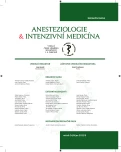Ultrasound assessment during admission of trauma and shocked patiens (FAST)
Authors:
Waldauf Petr
Authors‘ workplace:
Klinika anesteziologie a resuscitace, Fakultní nemocnice Královské Vinohrady, Praha
Published in:
Anest. intenziv. Med., 24, 2013, č. 5, s. 332-338
Category:
Postgraduate education - ECHO didactics
Sources
1. Ollerton, J. E., Sugrue, M., Balogh, Z. et al. Prospective study to evaluate the influence of FAST on trauma patient management. J. Trauma, 2006, 60, p. 785–791.
2. Wherrett, L. J., Boulanger, B. R., McLellan, B. A. et al. Hypotension after blunt abdominal trauma: The role of emergent abdominal sonography in surgical triage. J. Trauma, 1996, 41, p. 815–820.
3. Rose, J. S., Levitt, M. A., Porter, J. et al. Does the presence of ultrasound really affect computed tomographic scan use? A prospective randomized trial of ultrasound in trauma. J. Trauma, 2001, 51, p. 545–550.
4. Arrillaga, A., Graham, R., York, J. W. et al. Increased efficiency and cost-effectiveness in the evaluation of the blunt trauma pa-tient with the use of ultrasound. Am. Surg., 1999, 65, p. 31–35.
5. Branney, S. W., Moore, E. E., Cantrill, S. V. et al. Ultrasound based key clinical pathway reduces the use of hospital resources for the evaluation of blunt abdominal trauma. J. Trauma, 1997, 42, p. 1086–1090.
6. Rozycki, G. S., Ochsner, M. G., Feliciano, D. V. et al. Early detection of hemoperitoneum by ultrasound examination of the right upper quadrant: A multicenter study. J. Trauma, 1998, 45, p. 878–883.
7. Scalea, T. M., Rodriguez, A., Chiu, W. C. et al. Focused assessment with sonography for trauma (FAST): Results from an international consensus conference. J. Trauma, 1999, 46, p. 466–472.
8. Stengel, D., Bauwens, K., Rademacher, G. et al. Association between compliance with methodological standards of diagnostic research and reported test accuracy: Meta-analysis of focused assessment of US for trauma. Radiology, 2005, 236, p. 102–111.
9. Branney, S. W., Wolfe, R. E., Moore, E. E. et al. Quantitative sensitivity of ultrasound in detecting free intraperitoneal fluid.J. Trauma, 1995, 39, 2, p. 375–380.
10. Henneman, P. L., Marx, J. A., Moore, E. E. et al. Accuracy in predicting necessary laparotomy following blunt and penetrating trauma. J. Trauma, 1990, 30, p. 1345–1355.
11. Balik, M., Plasil, P., Waldauf, P., Pazout, J., Fric, M., Otahal, M., Pachl Ultrasound estimation of volume of pleural fluid in mechanically ventilated patients. J. Intensive Care Med., 2006, 32, 2, p. 318–321. Epub 2006 Jan 24.
12. Lichtenstein, D., Meziere, G., Biderman, P. et al. The “lung point”: An ultrasound sign specific to pneumothorax. Intensive Care Med., 2000, 26, p. 1434–1440.
13. Kirkpatrick, A. W., Sirois, M., Laupland, K. B., Liu, D., Rowan, K., Ball, C. G. et al. Hand-held thoracic sonography for detecting post-traumatic pneumothoraces: The extended focused assessment with sonography for trauma (EFAST). J. Trauma, 2004, 57, p. 288–295.
Labels
Anaesthesiology, Resuscitation and Inten Intensive Care MedicineArticle was published in
Anaesthesiology and Intensive Care Medicine

2013 Issue 5
Most read in this issue
- Multiple organ dysfunction syndrome
-
Skórovací schémata hodnocení sedace a výskytu deliria
I. Přehled skórovacích systémů hloubky sedace na JIP - Pre-eclampsia, eclampsia and HELLP syndrome from the anaesthesiologist’s perspective
- Ultrasound assessment during admission of trauma and shocked patiens (FAST)
